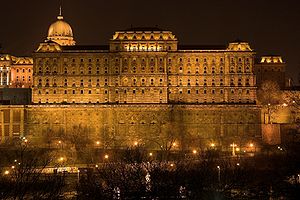
National Széchényi Library
Encyclopedia

Budapest
Budapest is the capital of Hungary. As the largest city of Hungary, it is the country's principal political, cultural, commercial, industrial, and transportation centre. In 2011, Budapest had 1,733,685 inhabitants, down from its 1989 peak of 2,113,645 due to suburbanization. The Budapest Commuter...
, Hungary
Hungary
Hungary , officially the Republic of Hungary , is a landlocked country in Central Europe. It is situated in the Carpathian Basin and is bordered by Slovakia to the north, Ukraine and Romania to the east, Serbia and Croatia to the south, Slovenia to the southwest and Austria to the west. The...
. It is one of the two Hungarian national libraries, the other being the University of Debrecen Library.
History
The library was founded in 1802 by the highly patriotic Hungarian aristocrat Count Ferenc Széchényi. Széchényi traveled the world buying Hungarian books, which he assembled and donated to the nation. In the following year the public library was opened in Pest. Széchényi's example resulted in a nationwide movement of book donations to the library.In 1808 the Hungarian National Assembly ("Diet
Diet (assembly)
In politics, a diet is a formal deliberative assembly. The term is mainly used historically for the Imperial Diet, the general assembly of the Imperial Estates of the Holy Roman Empire, and for the legislative bodies of certain countries.-Etymology:...
") created the Hungarian National Museum
Hungarian National Museum
- History:The Hungarian National Museum is said to have been founded in 1802 when Count Ferenc Széchényi set up the National Széchényi Library. This would then be followed a year later by the donating of a mineral collection by Széchényi’s wife. This led to the creation of the Hungarian National...
to collect the historical, archaeological and natural relics of Hungary. The Museum was merged into the Library and for the last 200 years this is how it has existed, a national depository for written, printed and objective relics of the Hungarian past.
In 1846 the Hungarian National Museum moved into its new building but it was not until 1949 that the Library became a separate entity again, with its current name. In 1985 the library moved to its new home at the Buda Castle Palace
Buda Castle
Buda Castle is the historical castle and palace complex of the Hungarian kings in Budapest, first completed in 1265. In the past, it was also called Royal Palace and Royal Castle ....
.
Collections
- Hungarian publishing houses printed copies for every printed material:
- publications and prints of any kind produced in Hungary
- works published abroad in the Hungarian language or written by Hungarian authors.
- non-book materials (sound recordings, video materials, electronic documents, etc.);
- 8 million items comprising :
- 2.5 million books
- 385,000 volumes of serial publications (newspapers and periodicals)
- 270,000 written and audio music documents
- 1 million manuscripts
- 200,000 maps, including the Tabula HungariaeTabula HungariaeTabula Hungariae is the earliest surviving printed map of Hungary, which has supposedly been made by Hungarian Lázár deák before 1528. It was inscribed on UNESCO's Memory of the World Register in 2007. -Description:...
, which was inscribed on UNESCOUNESCOThe United Nations Educational, Scientific and Cultural Organization is a specialized agency of the United Nations...
's Memory of the World Register in 2007 - 320,000 pictures and engravings
- 3 million posters and small prints.
- microfilm copies of more than 272,000 documents.
- Collection of Early Books
- the first book printed in Hungary, the Chronica HungarorumChronica HungarorumChronica Hungarorum is the title of several works treating the early Hungarian history.-Chronicon Pictum:...
("Chronicle of the Hungarians"), which was printed and published in 1473 - 8,600 copies of works published before 1711
- 1,814 incunabula dating from the first century of book printing
- the oldest existing text in HungarianHungarian languageHungarian is a Uralic language, part of the Ugric group. With some 14 million speakers, it is one of the most widely spoken non-Indo-European languages in Europe....
: the 12th century Funeral Sermon and PrayerFuneral Sermon and PrayerThe Funeral Sermon and Prayer is the oldest known and surviving contiguous Hungarian text, written by one scribal hand in the Latin script and dating to 1192-1195...
is the first known continuous prose text in Hungarian (and in the Uralic language family as a whole). - the first known Hungarian poem (Old Hungarian Lament of Mary the Virgin)
- the oldest surviving manuscript of the first Hungarian law-book
- 35 Corvina codicesCodexA codex is a book in the format used for modern books, with multiple quires or gatherings typically bound together and given a cover.Developed by the Romans from wooden writing tablets, its gradual replacement...
from the library of King Matthias CorvinusMatthias Corvinus of HungaryMatthias Corvinus , also called the Just in folk tales, was King of Hungary and Croatia from 1458, at the age of 14 until his death...
.
- the first book printed in Hungary, the Chronica Hungarorum

